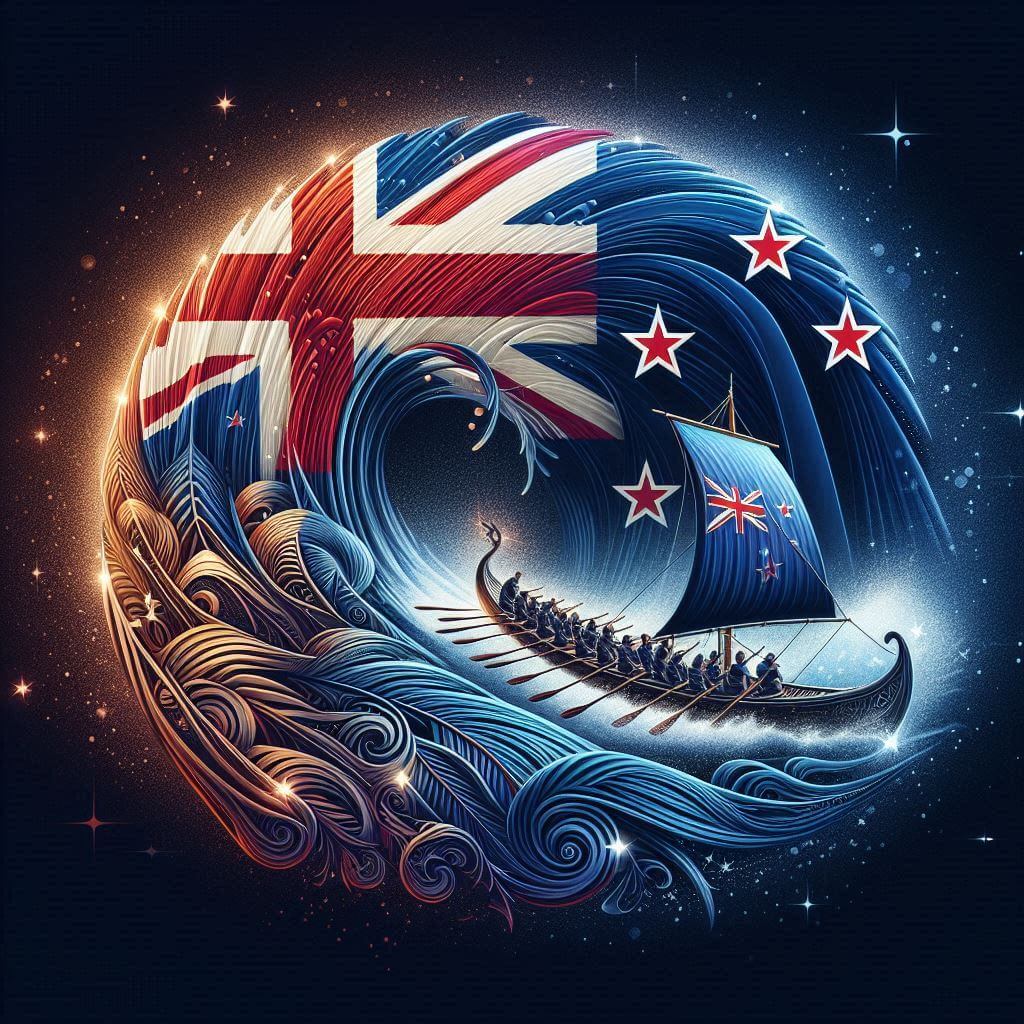The flag of New Zealand, also known as the New Zealand Ensign, features a blue field with the Union Jack in the canton (upper left quarter) and four red stars with white borders on the fly side (right half). This distinctive design combines elements of colonial heritage and Southern Hemisphere symbolism, reflecting New Zealand's unique identity and place in the world.
New Zealand information
| National Flag Day | — |
| Sovereign state | Yes |
| Official name | New Zealand |
| Capital | Wellington |
| Population | 4,957,586 |
| Area | 268,021 km² |
| Currency | New Zealand dollar (NZD) |
| Language | English, Māori |
| Continent | Oceania |
| Region | Australasia |
| Subregion | — |
| Borders | — |
| Timezone | New Zealand Time (NZT) UTC+12, Chatham Standard Time (CHAST) UTC+12:45 |
| Calling code | +64 |
| Top-level domain | .nz |
History of the New Zealand Flag
 The current design of the New Zealand flag was officially adopted on March 24, 1902, although it had been in use since 1869. The flag evolved from the British Blue Ensign, a common basis for flags of British colonies and territories. The addition of the Southern Cross constellation to the fly side made the flag distinctively New Zealand's. Prior to 1902, a flag with six stars was used, representing New Zealand's provinces at the time. The change to four stars simplified the design and aligned it more closely with the actual appearance of the Southern Cross in the night sky.
The current design of the New Zealand flag was officially adopted on March 24, 1902, although it had been in use since 1869. The flag evolved from the British Blue Ensign, a common basis for flags of British colonies and territories. The addition of the Southern Cross constellation to the fly side made the flag distinctively New Zealand's. Prior to 1902, a flag with six stars was used, representing New Zealand's provinces at the time. The change to four stars simplified the design and aligned it more closely with the actual appearance of the Southern Cross in the night sky.
Symbolism and Design of the New Zealand Flag
The New Zealand flag is rich in symbolism:
- The Union Jack in the canton acknowledges New Zealand's historical ties to the United Kingdom and its heritage as part of the British Empire.
- The blue field represents the Pacific Ocean, which surrounds the island nation.
- The four red stars with white borders depict the Southern Cross constellation, a significant navigational aid visible from New Zealand. This symbolizes the country's location in the South Pacific.
- The red color of the stars represents the vitality and vibrancy of the New Zealand people.
- The white borders around the stars enhance visibility against the blue background and symbolize the clarity of New Zealand's night sky.
Usage and Significance of the New Zealand Flag
 The New Zealand flag is a powerful symbol of national identity and pride. It is flown on government buildings, schools, and during national celebrations such as Waitangi Day (February 6) and ANZAC Day (April 25). The flag represents New Zealand in international forums, sporting events, and diplomatic occasions. It's also used on ships registered in New Zealand and on aircraft operated by the Royal New Zealand Air Force. The flag's design has sparked debates about its relevance in modern New Zealand, particularly regarding the representation of Māori culture and the country's evolving identity.
The New Zealand flag is a powerful symbol of national identity and pride. It is flown on government buildings, schools, and during national celebrations such as Waitangi Day (February 6) and ANZAC Day (April 25). The flag represents New Zealand in international forums, sporting events, and diplomatic occasions. It's also used on ships registered in New Zealand and on aircraft operated by the Royal New Zealand Air Force. The flag's design has sparked debates about its relevance in modern New Zealand, particularly regarding the representation of Māori culture and the country's evolving identity.
Interesting Facts About the New Zealand Flag
- In 2015-2016, New Zealand held a two-stage referendum on changing the national flag. The current design was retained after a closely contested vote.
- The silver fern, a national symbol often associated with New Zealand's sports teams, was a prominent feature in many of the alternative flag designs proposed during the referendum.
- The New Zealand flag is nearly identical to the flag of Australia, leading to occasional confusion. The key difference is that the New Zealand flag has four red stars with white borders, while the Australian flag has six white stars.
- The maritime version of the New Zealand flag (the New Zealand Red Ensign) features a red field instead of blue and is used by civilian ships registered in New Zealand.
- The stars on the New Zealand flag represent the constellation Crux, but their positioning is stylized rather than astronomically accurate.